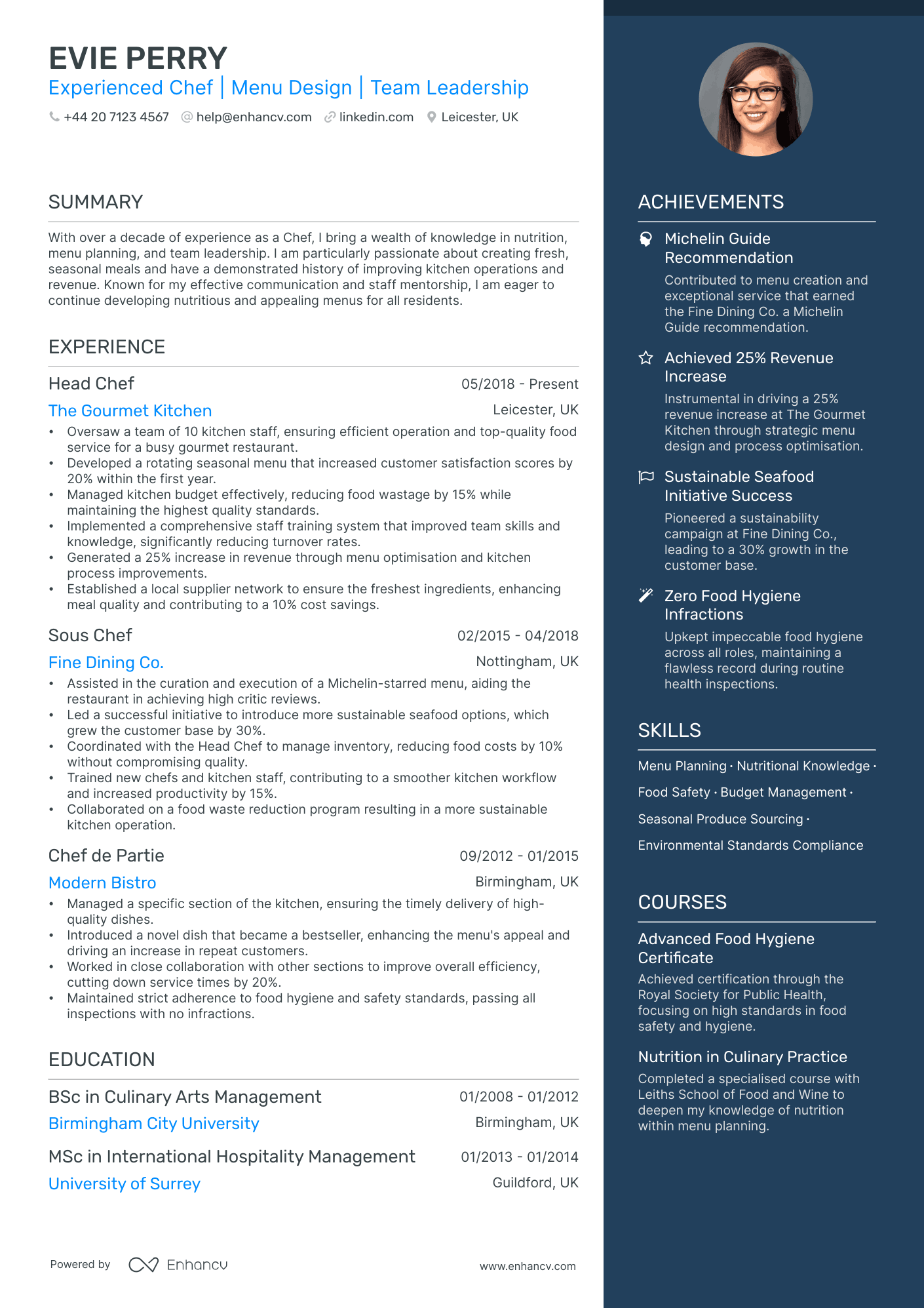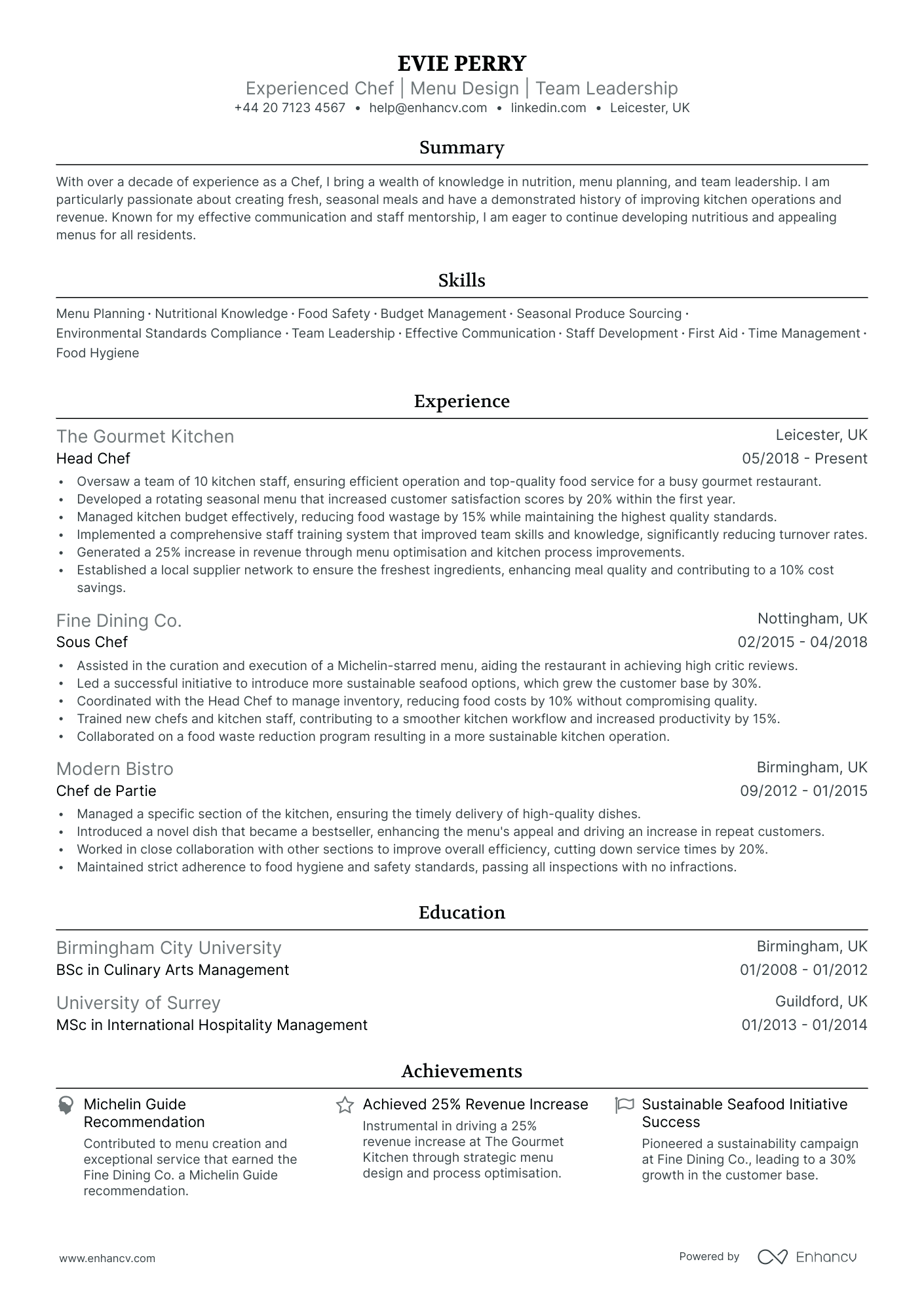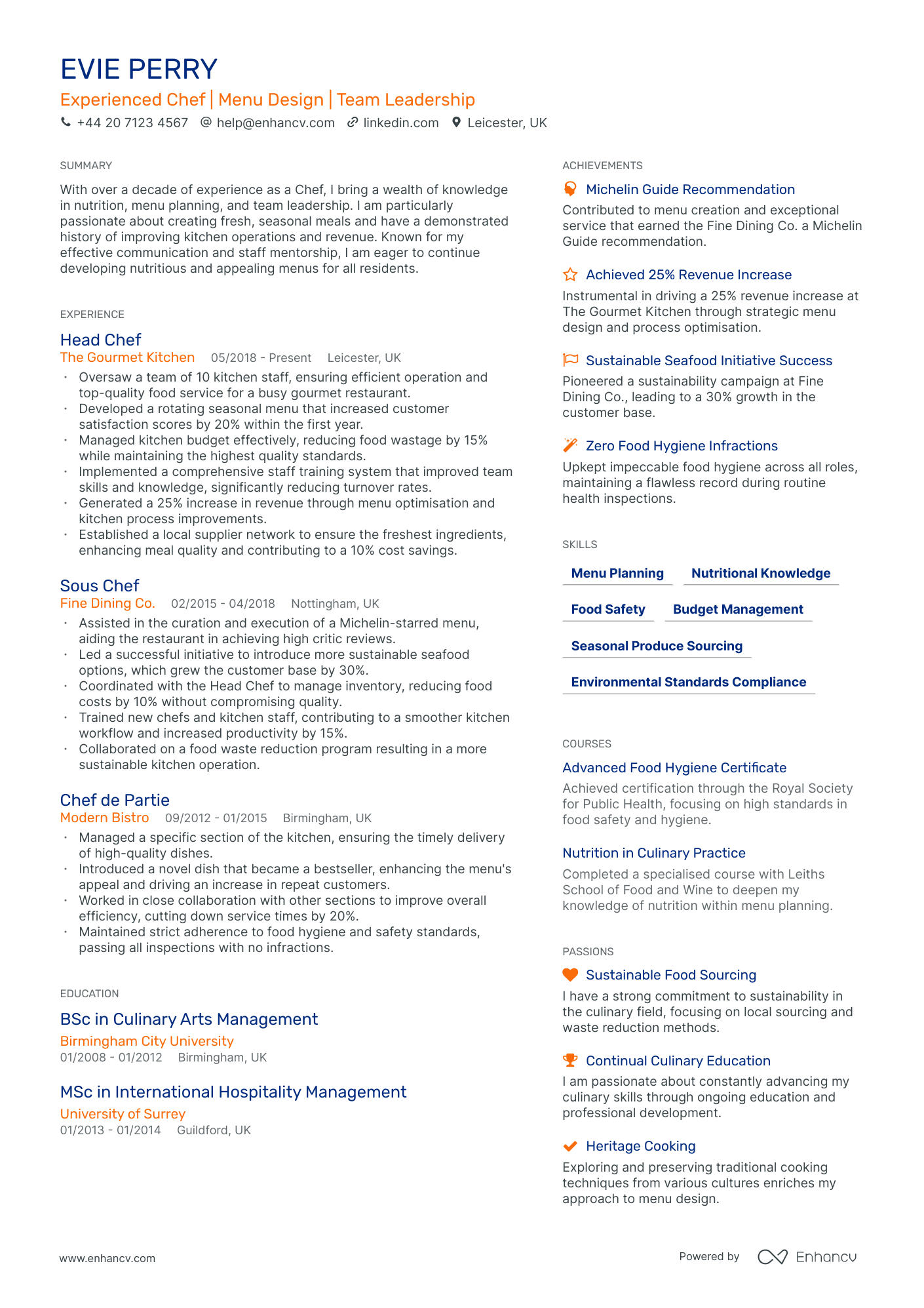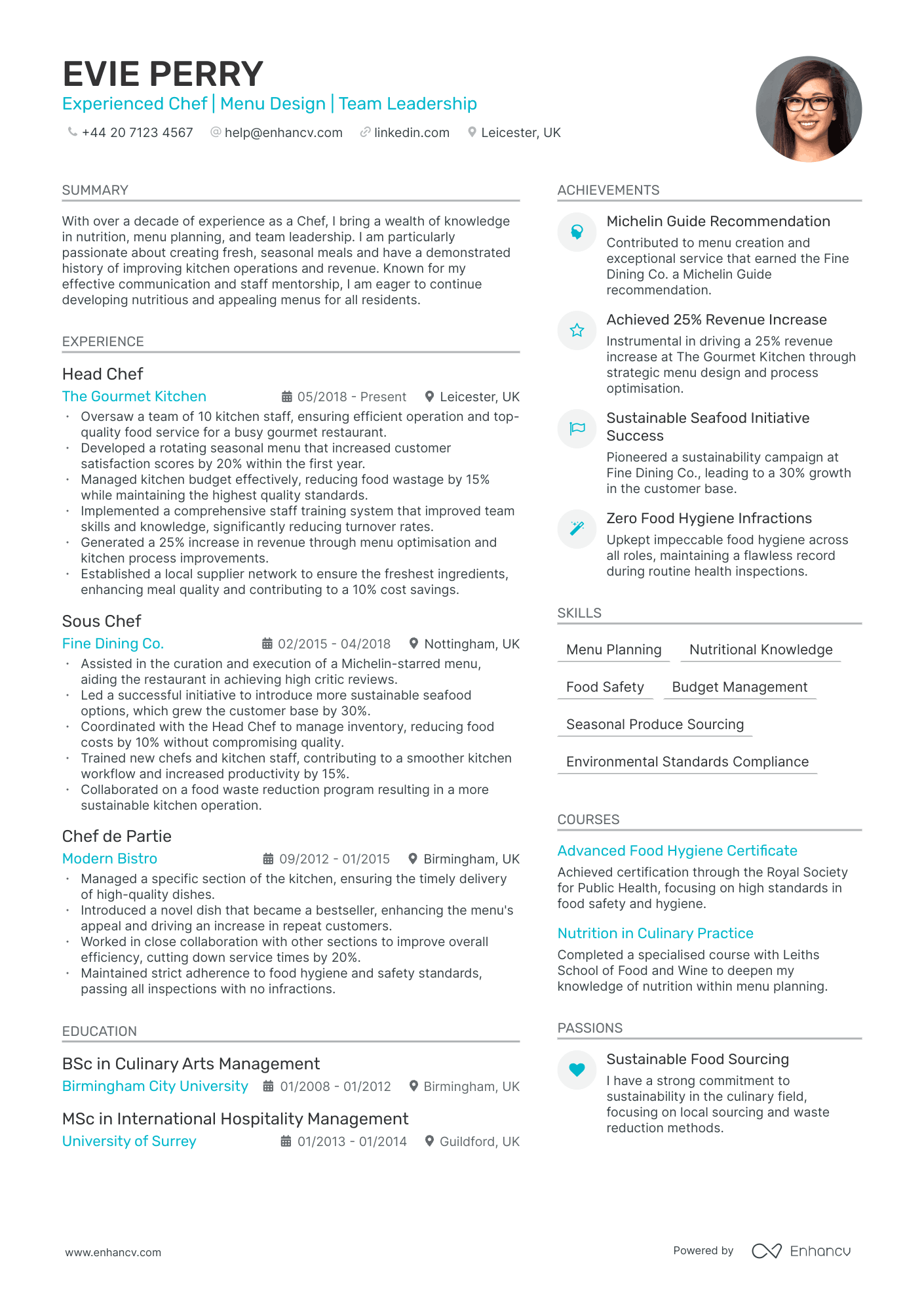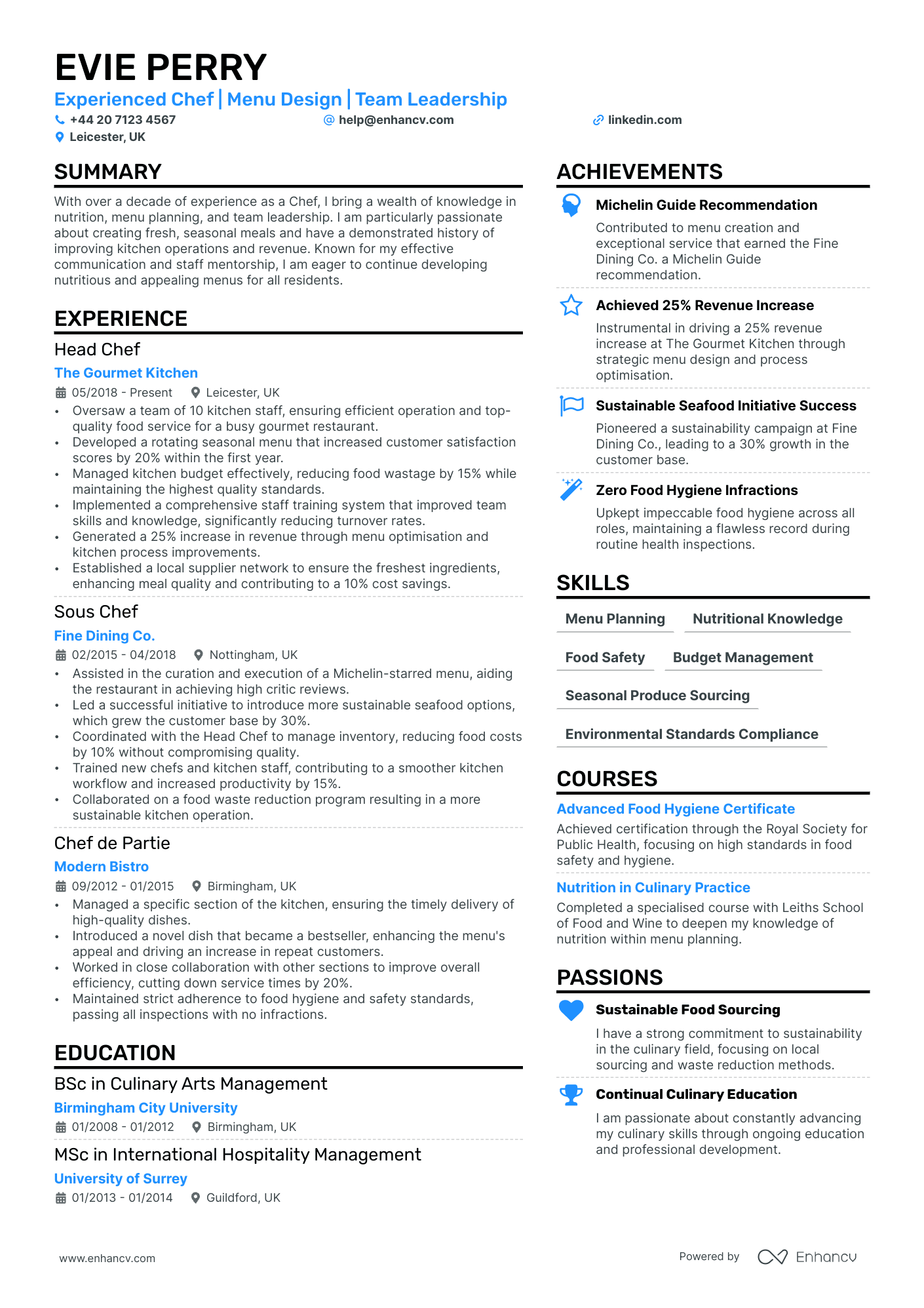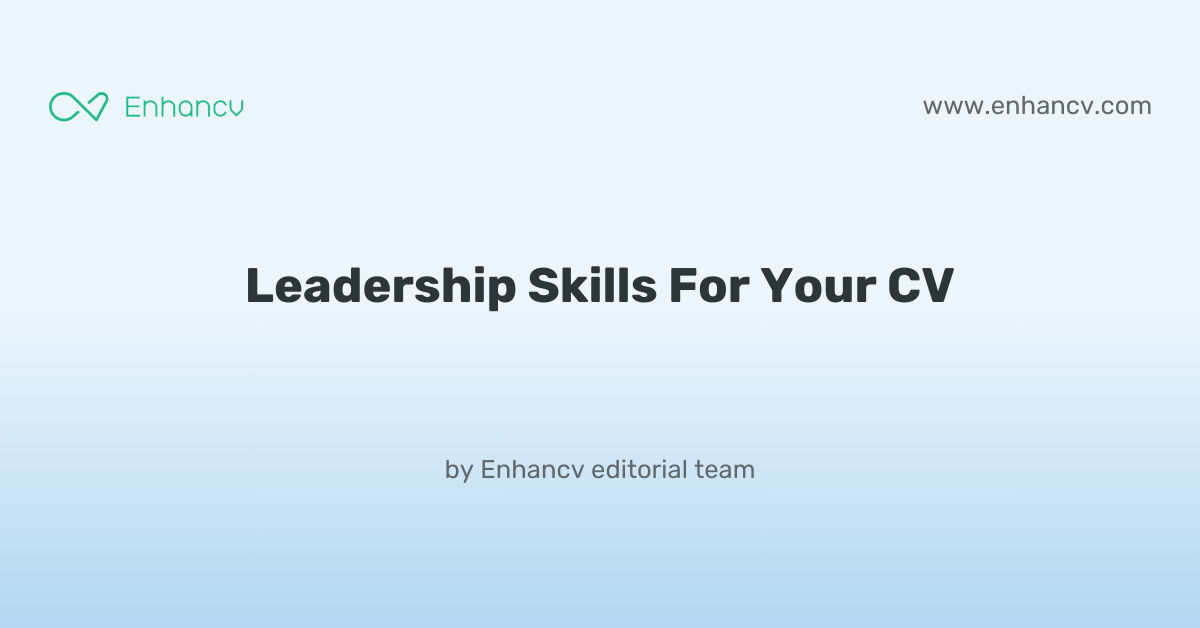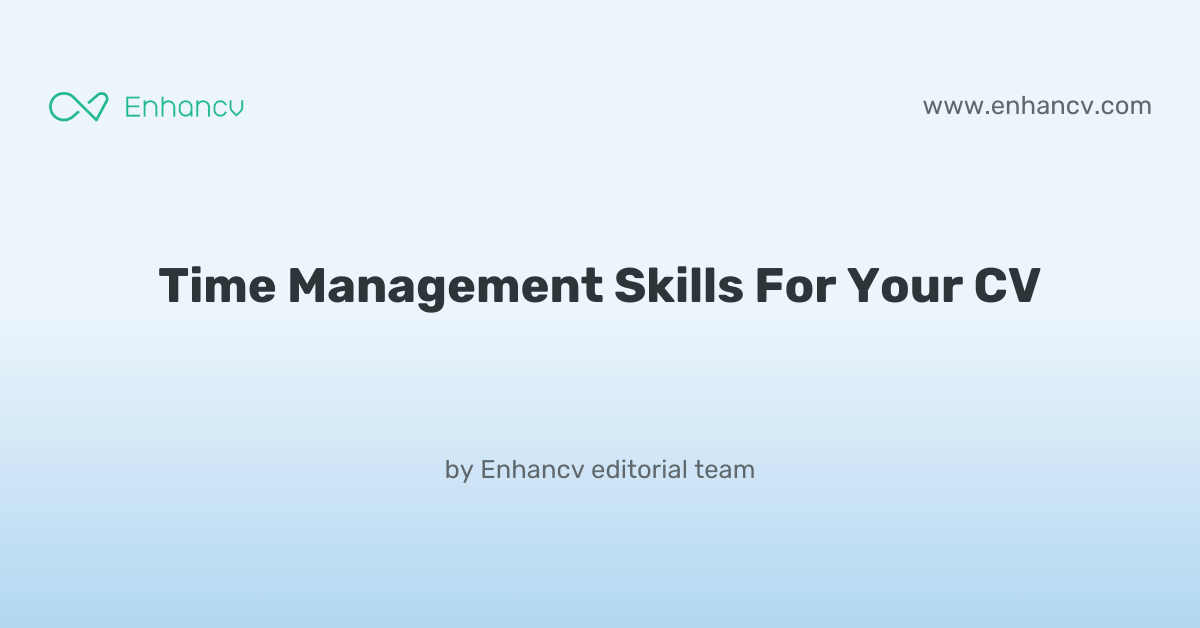Crafting a CV that accurately reflects your diverse culinary skills and creative flair can often feel as daunting as preparing a Michelin-starred dish. Fortunately, our guide is designed to walk you through each step, ensuring your CV is as compelling and well-presented as your signature courses.
- Create an attention-grabbing header that integrates keywords and includes all vital information;
- Add strong action verbs and skills in your experience section, and get inspired by real-world professionals;
- List your education and relevant certification to fill in the gaps in your career history;
- Integrate both hard and soft skills all through your CV.
Discover more industry-specific guides to help you apply for any role in the links below:
How to ensure your profile stands out with your chef CV format
It's sort of a Catch 22. You want your chef CV to stand out amongst a pile of candidate profiles, yet you don't want it to be too over the top that it's unreadable. Where is the perfect balance between your CV format simple, while using it to shift the focus to what matters most. That is - your expertise. When creating your chef CV:- list your experience in the reverse chronological order - starting with your latest roles;
- include a header with your professional contact information and - optionally - your photograph;
- organise vital and relevant CV sections - e.g. your experience, skills, summary/ objective, education - closer to the top;
- use no more than two pages to illustrate your professional expertise;
- format your information using plenty of white space and standard (2.54 cm) margins, with colours to accent key information.
Once you've completed your information, export your chef CV in PDF, as this format is more likely to stay intact when read by the Applicant Tracker System or the ATS. A few words of advice about the ATS - or the software used to assess your profile:
- Generic fonts, e.g. Arial and Times New Roman, are ATS-compliant, yet many candidates stick with these safe choices. Ensure your CV stands out by using a more modern, and simple, fonts like Lato, Exo 2, Volkhov;
- All serif and sans-serif fonts are ATS-friendly. Avoid the likes of fancy decorative or script typography, as this may render your information to be illegible;
- Both single- and double-column formatted CVs could be assessed by the ATS;
- Integrating simple infographics, icons, and charts across your CV won't hurt your chances during the ATS assessment.
PRO TIP
Incorporate a touch of colour in headers or section breaks, but keep it professional and ensure it doesn’t detract from readability, especially in more conservative industries.
The top sections on a chef CV
- Personal summary showcases a chef's passion and philosophy in cooking to establish a personal connection.
- Professional experience highlights the chef's practical knowledge and expertise in various kitchens.
- Culinary education details formal training and relevant qualifications that shape culinary skills.
- Specialised skills list specific culinary techniques and cuisines the chef excels in for targeted roles.
- Awards and accolades confirm recognition in the culinary field, signalling excellence to employers.
What recruiters value on your CV:
- Highlight your culinary expertise by detailing the range of cuisines you excel in, and any special techniques or dietary specialities you are proficient with, such as molecular gastronomy or vegan cooking.
- Emphasise leadership and management experience by mentioning the size of teams you've managed, kitchen operations you've overseen, and any mentoring of junior staff you've undertaken.
- Include notable achievements such as successful menu developments, contributions to increases in restaurant ratings or awards, and any unique culinary events or pop-ups you have orchestrated.
- Provide a detailed professional history that showcases career progression, specific roles and responsibilities at each establishment, and the duration of your tenure in each position.
- Mention any culinary education and qualifications, including apprenticeships, certifications, or degrees, and highlight continuous professional development through workshops or courses attended.
Recommended reads:
Making a good first impression with your chef CV header
Your typical CV header consists of Your typical CV header consists of contact details and a headline. Make sure to list your professional phone number, email address, and a link to your professional portfolio (or, alternatively, your LinkedIn profile). When writing your CV headline , ensure it's:
- tailored to the job you're applying for;
- highlights your unique value as a professional;
- concise, yet matches relevant job ad keywords.
You can, for examples, list your current job title or a particular skill as part of your headline. Now, if you decide on including your photo in your CV header, ensure it's a professional one, rather than one from your graduation or night out. You may happen to have plenty more questions on how to make best the use of your CV headline. We'll help you with some real-world examples, below.
Examples of good CV headlines for chef:
- Head Chef | Contemporary Italian Cuisine Specialist | Creativity in Gastronomy | 12 Years' Experience
- Executive Sous Chef | Menu Development Expert | Certified Cordon Bleu | Leadership in High-Volume Kitchens
- Pastry Chef | Artisan Baking & Confectionery | Innovative Dessert Creation | 8+ Years Culinary Expertise
- Senior Chef de Partie | Classical French Training | Efficient Team Management | 10 Years Professional Cooking
- Junior Sous Chef | Modern European Dishes | Passion for Sustainable Ingredients | Rising Culinary Talent
- Commis Chef | Culinary Arts Graduate | Eager and Swift Learner | 2 Years Dynamic Kitchen Experience
Catching recruiters' attention with your chef CV summary or objective
Located closer to the top of your CV, both the summary and objective are no more than five sentences long and serve as an introduction to your experience. What is more, you could use either to entice recruiters to read on. Select the:
- Summary, if you happen to have plenty of relevant experience. Feature your most impressive accomplishments and up to three skills that are relevant to the job you're applying for;
- Objective, if you're just starting your career off. Provide your career goals and answer how you see the role you are applying for will match your professional growth.
Judging which one you need to add to your chef CV may at times seem difficult. That’s why you need to check out how professionals, with similar to your experience, have written their summary or objective, in the examples below:
CV summaries for a chef job:
- With over a decade of experience in bustling metropolitan dining establishments, this seasoned chef brings a profound expertise in French and Italian cuisine, a history of streamlining kitchen operations to increase efficiency, and the proud achievement of leading a team to earn a coveted Michelin star.
- Passionate culinary professional with 15 years of dedicated experience in high-volume, prestigious hotel kitchens, excels in creating innovative fusion dishes, prioritises sustainable sourcing, and boasts the significant accomplishment of authoring a best-selling cookbook on modern Asian cuisine.
- Award-winning sommelier and mixologist eager to transition into the culinary arts, comes with 7 years of experience in curating world-class beverage experiences, a deep understanding of flavour pairings, and the creativity to craft memorable dining encounters complemented by exceptional drinks.
- Former military logistician making a career pivot to the culinary industry, carrying 8 years of disciplined supply chain management, proven abilities in team leadership under high-pressure environments, and a zealous commitment to mastering global culinary techniques and kitchen management.
- Aspiring chef with no previous kitchen experience but armed with a Professional Cookery Level 3 Diploma, aims to harness intense passion for regional Italian cooking and a commitment to learning from seasoned chefs in order to contribute fresh perspectives and deliver exceptional dining experiences.
- Enthusiastic newcomer with a recent Culinary Arts degree aims to apply theoretical knowledge, an innate flair for patisserie, and a strong dedication to pursuing excellence in culinary craftsmanship while absorbing every facet of kitchen operations within a dynamic and forward-thinking team.
How to meet job requirements with your chef CV experience
We've now reached the essence of your actual CV - your experience section. This is the space where you can list your career roles and on-the-job successes. Many candidates tend to underestimate just how much time and effort they should put into writing this CV section. Your experience shouldn't be a random list of your responsibilities, but instead:
- Match the job description with your skills, values, and accomplishments;
- Start each bullet with a strong action verb, followed up with one key skill and your outcome of applying this skill;
- Spotlight parts of your career history that are relevant to the job you're applying for.
Before we move on, make sure to check out some professional CV experience sections.
Best practices for your CV's work experience section
- Demonstrated expertise in menu development and planning, consistently updating and introducing innovative dishes that reflect seasonal availability and current gastronomic trends.
- Managed kitchen operations for a Michelin-starred restaurant, leading a team of 15 chefs and ensuring the highest quality of food presentation and hygiene standards.
- Excelled in a high-pressure environment, maintaining composure and delivering exceptional cuisine during busy services, with the ability to serve up to 250 covers per night.
- Skilfully managed food inventory and supply chain, reducing waste by 20% through strategic menu planning and fostering strong relationships with local suppliers for the freshest ingredients.
- Instrumental in achieving a 5-star food hygiene rating, by rigorously implementing and monitoring HACCP procedures and staff training initiatives.
- Developed and executed catering menus for high-end events, accommodating up to 500 guests, with bespoke options for diverse dietary requirements including vegan, gluten-free, and halal.
- Efficiently managed the budget, reducing kitchen costs by 10% through careful ingredient selection and negotiating favourable contracts with vendors.
- Actively participated in food festivals and culinary competitions, earning recognition for culinary excellence which enhanced the restaurant's reputation and customer base.
- Mentored junior chefs and apprentices, cultivating a supportive learning environment that led to two staff members achieving their own professional cooking qualifications.
- Pioneered a seasonal menu that leveraged local produce, reducing food costs by 15% while boosting customer satisfaction.
- Managed a kitchen staff of 12, fostering a collaborative environment that decreased employee turnover by 20%.
- Implemented rigorous health and safety protocols that ensured a 100% pass rate on all health inspections.
- Oversaw the successful launch of a fine dining restaurant, consistently exceeding revenue targets by at least 30% each quarter.
- Cultivated relationships with premium food suppliers, ensuring the regular delivery of high-quality ingredients.
- Initiated a series of cooking workshops which increased brand visibility and added a 10% revenue stream to the business.
- Directed culinary operations in a high-volume environment, serving up to 500 covers per night with exceptional quality control.
- Collaborated with the marketing team to create immersive dining experiences, resulting in a 25% increase in repeat customers.
- Integrated farm-to-table concepts that led to a partnership with local farmers, aligning with green initiatives and enhancing menu freshness.
- Redesigned the kitchen layout to optimize workflow, thereby increasing kitchen output by 35% while maintaining high-quality standards.
- Mentored junior chefs, leading to two sous chefs winning regional cooking competitions which elevated the restaurant's reputation.
- Initiated a cost-saving strategy by revamping the inventory system, leading to a 20% reduction in food waste.
- Developed and executed a successful concept menu that increased customer traffic during off-peak hours by 40%.
- Negotiated with vendors for better pricing on high-volume items, saving the restaurant an average of $6,000 monthly on food costs.
- Contributed to a 50% increase in catering event business through innovative menu design and exceptional execution.
- Orchestrated the logistical planning and management of kitchen operations for events averaging 300 guests, maintaining a customer satisfaction rate of 95%.
- Developed a comprehensive training manual for new kitchen hires that reduced onboarding time by 30%.
- Created a waste reduction program that successfully cut down food waste by 25%, positively impacting profitability.
- Led a team of chefs in a boutique hotel setting, enhancing the dining experience which resulted in a 20% year-over-year increase in restaurant sales.
- Implemented a locally-inspired seasonal menu that contributed to a 15% increase in average check size.
- Coordinated with the hospitality team to develop signature dishes for VIP guests, leading to high-profile coverage in regional food magazines.
- Played a key role in a popular downtown food truck business, serving over 200 transactions daily with consistent positive customer feedback.
- Managed supply chain logistics to accommodate mobile operation, which enhanced operational efficiency by 20%.
- Fostered a dynamic and fast-paced service environment that became a benchmark for other food trucks in the area.
- Curated special menu items for holiday events that augmented restaurant bookings by 50% during festive periods.
- Successfully managed kitchen budgets to maintain profitability margins despite a 10% increase in ingredient prices.
- Championed a kitchen garden initiative that supplied 20% of the herbs used in dishes, enhancing flavors and reducing cost.
- Contributed to a 30% growth in the restaurant's social media engagement through the designing of photogenic, 'Instagrammable' dishes.
- Optimized kitchen operations by incorporating advanced cooking technologies, which reduced cooking times by an average of 15%.
- Developed a partnership with a local culinary school to provide internships, fostering community relations and providing a pipeline of trained staff.
What to add in your chef CV experience section with no professional experience
If you don't have the standard nine-to-five professional experience, yet are still keen on applying for the job, here's what you can do:
- List any internships, part-time roles, volunteer experience, or basically any work you've done that meets the job requirements and is in the same industry;
- Showcase any project you've done in your free time (even if you completed them with family and friends) that will hint at your experience and skill set;
- Replace the standard, CV experience section with a strengths or achievements one. This will help you spotlight your transferrable skills that apply to the role.
Recommended reads:
PRO TIP
Talk about any positive changes you helped bring about in your previous jobs, like improving a process or helping increase efficiency.
Hard skills and soft skills to showcase your unique skill set on your chef CV
Did you know that your CV will mostly likely be assessed by recruiters based on skill alignment? And that means that the way you feature your key skills across different CV sections will play a crucial role in landing you that first interview. We recommend you add your:
- technical capabilities or hard skills in your CV experience, certificates, projects, etc. Use your past accomplishments to prove your technical capabilities. List up to a dozen different software or hardware in your dedicated skills section to match the job keywords;
- personal and communication skills or soft skills in your CV strengths, achievements, summary/ objective, etc. Soft skills are a bit more difficult to prove. How do you define your aptitude in active listening? So, instead of just listing the skill name, include a tangible metric to show your success.
On a final note, when you're in a hurry to create your profile, you may misspell a particular technology or soft skill. That's why we suggest you copy and paste the particular skill name (or keyword), directly from the job advert. This would also help you to pass any initial Applicant Tracker System (ATS) tests.
Top skills for your chef CV:
Culinary Expertise
Food Preparation
Menu Development
Inventory Management
Food Safety Knowledge
Pastry and Baking Skills
Butchery
Knowledge of Different Cuisines
Plate Presentation
Cost Control
Leadership
Time Management
Creativity
Teamwork
Attention to Detail
Stress Management
Adaptability
Problem-Solving
Effective Communication
Customer Service Orientation
PRO TIP
Use mini case studies or success stories in your CV to demonstrate how your skills have positively impacted previous roles or projects.
Education and more professional qualifications to include in your chef CV
If you want to showcase to recruiters that you're further qualified for the role, ensure you've included your relevant university diplomas. Within your education section:
- Describe your degree with your university name(-s) and start-graduation dates;
- List any awards you've received, if you deem they would be impressive or are relevant to the industry;
- Include your projects and publications, if you need to further showcase how you've used your technical know-how;
- Avoid listing your A-level marks, as your potential employers care to learn more about your university background.
Apart from your higher education, ensure that you've curated your relevant certificates or courses by listing the:
- name of the certificate or course;
- name of the institution within which you received your training;
- the date(-s) when you obtained your accreditation.
In the next section, discover some of the most relevant certificates for your chef CV:
PRO TIP
If there's a noticeable gap in your skillset for the role you're applying for, mention any steps you're taking to acquire these skills, such as online courses or self-study.
Recommended reads:
Key takeaways
Write your professional chef CV by studying and understanding what the role expectations are. You should next:
- Focus on tailoring your content to answer specific requirements by integrating advert keywords through various CV sections;
- Balance your technical know-how with your personal skills to showcase what the unique value would be of working with you;
- Ensure your CV grammar and spelling (especially of your key information and contact details) is correct;
- Write a CV summary, if your experience is relevant, and an objective, if your career ambitions are more impressive;
- Use active language by including strong, action verbs across your experience, summary/objective, achievements sections.
